Shizuoka
静岡市 | |
|---|---|
| City of Shizuoka[1] | |
 Top left: Aoba Symbol Road; Top right: Shimizu Port Middle: Tōkaidō Shinkansen & Urban area Aoi Tower,Keyaki Street,Higashi-Shizuoka subcenter,Gofukucho, Kunozan Toshogu | |
 | |
 Location of Shizuoka in Shizuoka Prefecture | |
| Coordinates: 34°58′32″N 138°22′58″E / 34.97556°N 138.38278°E | |
| Country | Japan |
| Region | Chūbu (Tōkai) |
| Prefecture | Shizuoka Prefecture |
| First official record | 663 AD |
| City Status | 1 April 1889 |
| Government | |
| • Mayor | Takashi Namba |
| Area | |
| • Total | 1,411.90 km2 (545.14 sq mi) |
| Population (September 1, 2023) | |
| • Total | 677,867 |
| • Density | 480/km2 (1,200/sq mi) |
| Time zone | UTC+9 (Japan Standard Time) |
| Symbols | |
| • Tree | Flowering dogwood |
| • Flower | Hollyhock |
| • Bird | Common kingfisher |
| Phone number | 054-254-2111 |
| Address | 5-1 Ōtemachi, Aoi-ku, Shizuoka-shi, Shizuoka-ken 420-8602 |
| Website | Official website |
Shizuoka (静岡市, Shizuoka-shi, [ɕizɯꜜoka]) is the capital city of Shizuoka Prefecture, Japan, and the prefecture's second-largest city in both population and area. It has been populated since prehistoric times. As of 1 September 2023,[update] the city had an estimated population of 677,867 in 106,087 households,[2] and a population density of 480 inhabitants per square kilometre (1,200/sq mi).
The city's name is made up of two kanji, 静 shizu, meaning "still" or "calm"; and 岡 oka, meaning "hill(s)".[3] In 1869, Shizuoka Domain was first created out of the older Sunpu Domain, and that name was retained when the city was incorporated in 1885. In 2003, Shizuoka absorbed neighboring Shimizu City (now Shimizu Ward) to create the new and expanded city of Shizuoka, briefly becoming the largest city by land area in Japan. In 2005, it became one of Japan's "designated cities".
Shizuoka City lies in central Shizuoka Prefecture, about halfway between Tokyo and Nagoya along the Tōkaidō Corridor, between Suruga Bay to the south and the Minami Alps in the north. Shizuoka had the largest area of any municipality in Japan after merging with Shimizu City in April 2003, until February 2005, when Takayama in Gifu Prefecture superseded it by merging with nine surrounding municipalities.
The total area of the city is 1,411.90 km2 (545.14 sq mi).[4] Shizuoka is the 5th largest city in Japan in terms of geographic area after Takayama, Hamamatsu, Nikkō, and Kitami. It is also the 2nd largest city in Shizuoka Prefecture in terms of both geographic area and population after Hamamatsu, but ranks higher as an Urban Employment Area,[5] and leads as a metropolitan area and business region.
The fan-like shape of the Shizuoka Plain and Miho Peninsula were formed over the ages by the fast-flowing Abe River, carrying along collapsed sand and earth. These areas form the foundations of the city today.[6]: 242 The isolated Mount Kunō separates the Suruga coastline from the Shimizu coastline.

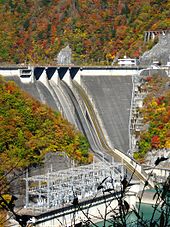
On the south-central Pacific coast Shizuoka has a humid subtropical climate (Köppen climate classification Cfa), which is hot and humid in the summer, and rarely snows in the winter.[7] It is close to the warm Kuroshio Current and is wet even by Japanese standards with only slightly less precipitation than Kanazawa on the opposite side of Honshū, but it is paradoxically the sunniest of Japan's major cities owing to the absence of summer fog and its sheltered location from the northwesterly winds off the Sea of Japan. Further north, the mountainous Ikawa area is part of the Japanese snow country, where there are ski areas.
| Climate data for Shizuoka (1991−2020 normals, extremes 1940−present) | |||||||||||||
|---|---|---|---|---|---|---|---|---|---|---|---|---|---|
| Month | Jan | Feb | Mar | Apr | May | Jun | Jul | Aug | Sep | Oct | Nov | Dec | Year |
| Record high °C (°F) | 25.7 (78.3) |
26.2 (79.2) |
28.0 (82.4) |
33.3 (91.9) |
33.9 (93.0) |
38.3 (100.9) |
40.0 (104.0) |
38.7 (101.7) |
37.1 (98.8) |
33.9 (93.0) |
28.0 (82.4) |
24.5 (76.1) |
40.0 (104.0) |
| Mean daily maximum °C (°F) | 11.7 (53.1) |
12.6 (54.7) |
15.5 (59.9) |
19.8 (67.6) |
23.5 (74.3) |
26.1 (79.0) |
29.9 (85.8) |
31.3 (88.3) |
28.4 (83.1) |
23.6 (74.5) |
18.8 (65.8) |
14.1 (57.4) |
21.3 (70.3) |
| Daily mean °C (°F) | 6.9 (44.4) |
7.7 (45.9) |
10.7 (51.3) |
15.2 (59.4) |
19.2 (66.6) |
22.4 (72.3) |
26.1 (79.0) |
27.4 (81.3) |
24.5 (76.1) |
19.4 (66.9) |
14.3 (57.7) |
9.3 (48.7) |
16.9 (62.4) |
| Mean daily minimum °C (°F) | 2.1 (35.8) |
2.9 (37.2) |
6.0 (42.8) |
10.6 (51.1) |
15.1 (59.2) |
19.2 (66.6) |
23.1 (73.6) |
24.2 (75.6) |
21.1 (70.0) |
15.6 (60.1) |
9.9 (49.8) |
4.6 (40.3) |
12.9 (55.2) |
| Record low °C (°F) | −6.8 (19.8) |
−5.8 (21.6) |
−4.6 (23.7) |
−1.4 (29.5) |
5.1 (41.2) |
12.5 (54.5) |
15.4 (59.7) |
16.9 (62.4) |
10.6 (51.1) |
3.9 (39.0) |
−1.7 (28.9) |
−5.1 (22.8) |
−6.8 (19.8) |
| Average precipitation mm (inches) | 79.6 (3.13) |
105.3 (4.15) |
207.1 (8.15) |
222.2 (8.75) |
215.3 (8.48) |
268.9 (10.59) |
296.6 (11.68) |
186.5 (7.34) |
280.6 (11.05) |
250.3 (9.85) |
134.2 (5.28) |
80.7 (3.18) |
2,327.3 (91.63) |
| Average snowfall cm (inches) | 0 (0) |
0 (0) |
0 (0) |
0 (0) |
0 (0) |
0 (0) |
0 (0) |
0 (0) |
0 (0) |
0 (0) |
0 (0) |
0 (0) |
0 (0) |
| Average precipitation days (≥ 0.5 mm) | 5.8 | 6.5 | 10.2 | 10.5 | 10.9 | 13.6 | 12.9 | 10.6 | 12.8 | 10.9 | 7.6 | 6.1 | 118.3 |
| Average relative humidity (%) | 57 | 57 | 62 | 65 | 71 | 77 | 79 | 76 | 75 | 71 | 67 | 60 | 68 |
| Mean monthly sunshine hours | 207.9 | 187.5 | 189.9 | 189.7 | 192.0 | 135.9 | 157.9 | 201.8 | 157.3 | 157.7 | 173.3 | 200.5 | 2,151.5 |
| Source: Japan Meteorological Agency[8] | |||||||||||||
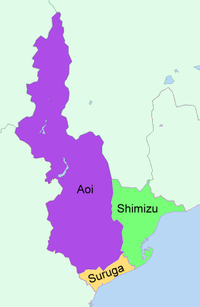
On 22 December 2006, colours and logos were established for each of the wards.[9]
| Aoi Ward | ■ Aoi Ward Green |
|---|---|
| Suruga Ward | ■ Suruga Ward Red |
| Shimizu Ward | ■ Shimizu Ward Blue |
As of August 2019,[update] the city had an estimated population of 704,989 in 286,013 households[2] and a population density of 507 inhabitants per square kilometre (1,310/sq mi).

| Demographic | Population | As of |
|---|---|---|
| Male | 343,339 | August 2019[2] |
| Female | 361,651 | |
| Households | 286,013[2] | |
| Foreign | 9,389 | May 2019[2] |
| Total | 704,989 | August 2019[2] |
Per Japanese census data,[10] the population of Shizuoka has been declining slowly since 1990.
| Year | Pop. | ±% |
|---|---|---|
| 1940 | 395,189 | — |
| 1950 | 467,782 | +18.4% |
| 1960 | 576,482 | +23.2% |
| 1970 | 681,797 | +18.3% |
| 1980 | 727,260 | +6.7% |
| 1990 | 739,300 | +1.7% |
| 2000 | 729,980 | −1.3% |
| 2010 | 716,328 | −1.9% |
| 2020 | 693,389 | −3.2% |
|
|



The area that is now the city of Shizuoka has been inhabited since prehistoric times. Numerous kofun have been found within the city limits, and the Toro archaeological site indicates that a major Yayoi period (circa 400 BC–300 AD) settlement existed in what is now part of the central city area.
Suruga was established as a province of Japan in the early Nara period. At some point between the year 701 and 710, the provincial capital was relocated from what is now Numazu, to a more central location on the banks of the Abe River at a location named Sunpu (駿府) (a contraction of "Suruga no Kokufu" (駿河の国府)) or alternatively "Fuchū" (府中).
During the Muromachi period, Sunpu was the capital of the Imagawa clan. The Imagawa were defeated at the Battle of Okehazama, and Sunpu was subsequently ruled by Takeda Shingen, followed by Tokugawa Ieyasu. However, Toyotomi Hideyoshi relocated Ieyasu, and installed Nakamura Kazutada to rule Sunpu. After the Toyotomi were defeated in the Battle of Sekigahara, Ieyasu recovered Sunpu, reassigning it to his own retainer, Naitō Nobunari in 1601. This marked the start of Sunpu Domain.
In April 1606, Ieyasu officially retired from the post of shōgun, and retired to Sunpu, where he established a secondary court, from which he could influence Shōgun Tokugawa Hidetada from behind the scenes. Subsequently, aside for brief periods, Sunpu was tenryō (territory under direct administration by the Shogunate), ruled by the Sunpu jōdai (駿府城代), an appointed official based in Sunpu.
In 1869, after the fall of the Tokugawa shogunate, the former shogunal line, headed by Tokugawa Iesato was sent to Sunpu and assigned the short-lived Sunpu Domain. The same year, Sunpu was renamed "Shizuoka". Shizuoka Domain became Shizuoka Prefecture with the abolition of the han system in 1871, which was expanded in 1876 through merger with the former Hamamatsu Prefecture and western portions of Ashigaru Prefecture in 1876. Shizuoka Station on the Tōkaidō Main Line was opened on 1 February 1889. The same day, a fire burned down most of downtown Shizuoka.
The modern city was founded on 1 April 1889. At the time, the population was 37,681, and Shizuoka was one of the first 31 cities established in Japan.
An electric tram service began in 1911. In 1914, due to heavy rains caused by a typhoon, the Abe River flooded, inundating the downtown area.[11] In the national census of 1920, the population of Shizuoka was 74,093. The area of the city continued to expand through the 1920s and 1930s through merger with outlying towns and villages. In 1935, the city was struck by a 6.4 magnitude earthquake, resulting in much damage. Although soon rebuilt, a large fire in 1940 again destroyed much of the center of the city.
During World War II, Shizuoka lacked targets of major military significance, and was initially only lightly bombed during several American air raids. However, in a major firebombing raid of 19 June 1945, the city suffered an extreme amount of damage with high civilian casualties.
The area of the city continued to expand through the 1950s and 1960s through merger with outlying towns and villages. On 1 October 1964, the Tōkaidō Shinkansen began services to Shizuoka, and on 25 April 1969 the city was connected to the Tōmei Expressway. On 7 July 1974, the Abe River flooded, and landslides occurred during heavy rains, killing 23 people.[citation needed] On 16 August 1980, a major gas leak in an underground shopping center near Shizuoka Station resulted in an explosion, killing 15 people and seriously injuring 233 others. The Shizuoka City Hall moved to new premises in 1986. On 1 April 1992, Shizuoka was designated a core city by the central government, giving it increased autonomy.[12]
The 1 April 2003 merger with Shimizu City (current Shimizu Ward) greatly expanded the area and population of Shizuoka,[13] which then became a designated city on 1 April 2005,[14] and was divided into three wards. [citation needed]
Despite being somewhat geographically isolated from the rest of the city, the town of Kanbara (from Ihara District) was merged into Shizuoka on 31 March 2006,[15] becoming part of Shimizu-ku. On 1 November 2008, the town of Yui (also from Ihara District) was also merged into Shimizu-ku, resulting in the dissolution of Ihara District.[16]
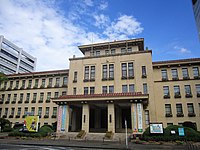

Shizuoka has a mayor-council form of government with a directly elected mayor and a unicameral city legislature of 48 members. The city contributes 13 members to the Shizuoka Prefectural Assembly. In terms of national politics, the city is divided between Shizuoka 1st district and Shizuoka 4th district in the lower house of the Japanese Diet.
|
|
|
|
| Term | Name | Start | Finish |
|---|---|---|---|
| 1–2 | Zenkichi Kojima | 14 April 2003 | 12 April 2011 |
| 3–6 | Nobuhiro Tanabe | 13 April 2011 | 12 April 2023 |
| 7 | Takashi Namba | 13 April 2023 | current |
Shizuoka has twin and friendship relationships with several cities.[17][18]
| City | Country | State | since |
|---|---|---|---|
| Stockton | California | October 16, 1959 | |
| Omaha | Nebraska | April 1, 1965 | |
| Shelbyville | Indiana | November 3, 1989 | |
| Cannes | Provence-Alpes-Côte d'Azur | November 5, 1991[19] |
| City | Country | State | since |
|---|---|---|---|
| Huế | Thừa Thiên Huế province | April 12, 2005 |
| City | Prefecture | region | since |
|---|---|---|---|
| Muroran | Hokkaidō region | December 24,1976 | |
| Jōetsu | Chūbu region | October 12, 1995 |
| City | Prefecture | region | since |
|---|---|---|---|
| Saku | Chūbu region | October 12, 1989 |

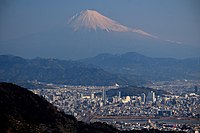




Shizuoka has 35,579 businesses as of 2012.[4]
Employment by industry: Agriculture 0.1%, Manufacturing: 26.9%, Service 73.0%
Greater Shizuoka, Shizuoka Metropolitan Employment Area, has a GDP of US$45.8 billion as of 2010.[20][21]
Shizuoka's GDP per capita (PPP) 2014 was US$41,472.[22]
Fuji Dream Airlines is headquartered in Aoi-ku, Shizuoka.[23]
Shimizu Port boasts the largest haul of tuna in all Japan.[citation needed] Kanbara Harbour enjoys a prosperous haul of sakura ebi, and Mochimune Harbour enjoys a prosperous haul of shirasu sardines.
Abekawa Mochi is a type of rice cake (or mochi) made with kinako soy flour that is a specialty of Shizuoka.
Shizuoka has a long history of being involved in the craft industries going back over 400 years ago, using trees, including hinoki cypress. The model industry goes back to the late 1920s when wood was used to produce model toys, using sashimono woodworking joinery techniques, purely for educational purposes. Craftsmen later moved on to lighter woods including balsa, but following the war, with the importation of US built scale models, many companies either turned to plastic models to compete or went under.[29][30]
The town has since become internationally notable for its plastic scale model kits[31] and is resident to long-established companies such as Aoshima, Fujimi, Hasegawa, and Tamiya. Another model brand, Bandai, produces its Gundam models exclusively at its Bandai Hobby Center plant in the city.[32] The city hosts the long-running Shizuoka Hobby Show annually in May at Twin Messe Shizuoka.[33]

The Shizuoka Shimbun is the area's primary newspaper.
The book trilogy “Paper Gods” by Amanda Sun takes place in this city.
Shizuoka Cable Television (Dream Wave Shizuoka)


Shizuoka has 91 elementary schools, 57 middle schools and 27 high schools. In addition there are 29 vocations schools and 12 public libraries.


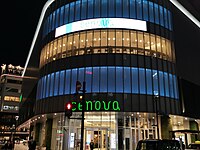
The nearest airport is Shizuoka Airport, situated between Makinohara and Shimada.
Shizuoka lies on the Tōkaidō Main Line, the JR Central main railway line from Tokyo to Osaka, and is well-served by the Tōkaidō Shinkansen, limited express and regional trains. The central station of Shizuoka is in the city centre. Shizuoka also has an LRT line, the Shizuoka Railway, administered by the Shizuoka Railway Co., Ltd. at Shizuoka Station. The under construction Chūō Shinkansen will pass through the mountainous area in the northern tip of the city. However, the line is not planned to have a station in Shizuoka.
The Port of Shimizu-ku, in Shimizu City (now Shimizu Ward), is a long established mid-size sea port, catering to container ships, dry bulk ships and cruise ships.[35]
It is well located, being in between the two major port areas of Japan, i.e. the Tokyo Bay ports of Tokyo, Kawasaki and Yokohama (Keihin ports) and the Osaka Bay ports of Osaka and Kobe (Hanshin ports). The Port of Shimizu has a water depth of about 12 metres (39 ft); its attractiveness has been enhanced over the past years by the construction of new road and rail links which contribute to expanding its commercial hinterland.
In tonnage, imports (about 6.5 million tonnes (6,400,000 long tons; 7,200,000 short tons)) are close to twice export volumes, but in trade value exports are twice as valuable as imports.
The Port of Shimizu container traffic is about balanced, with over 250,000 TEU in each direction, with auto parts and chemicals amongst the main cargo types. Major international container lines provide weekly services on major trade routes, including North America, Europe and Asia, with about 110 calls per months on 28 trade routes.
The port of Shimizu also includes a terminal to receive LNG tankers and store imported Liquefied natural gas; it is operated by Shimizu LNG, a subsidiary of Shizuoka Gas (Japan is the world's largest importer of LNG).
The Port of Shimizu is also connected to other Japan ports. In particular, it is served by a Roll-on/roll-off service serving the port of Ōita, on the north-east coast of the southern island of Kyushu. This service, which sails three times a week and has a transit time of 20 hours, has enabled a modal shift of freight trucks from road to sea, thereby contributing to decreasing congestion and pollution on roads.


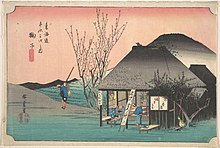
The Shizuoka Performing Arts Center (SPAC) was founded in 1995 by the Shizuoka Prefecture.[40] The building was designed by architect Arata Isozaki[41] and was opened in 1999 for the second Theatre Olympics.[42]
The arts center is the first publicly funded cultural organization in Japan to have its own troupe of actors and other staff to manage its own venues and facilities for artistic purposes. Suzuki Tadashi was the first Artistic Director, appointed in 1997 and staying in the position until March 2007, after which Miyagi Satoshi took up the appointment.[40] SPAC has organised the World Theatre Festival Shizuoka each year since 2011,[43] as well as creating its own theatre productions (some of which tour abroad), having students to learn at the center, and other theatrical activities.[40]
The World Theatre Festival Shizuoka was formerly called the Shizuoka Spring Festival (2000-2010[43]), being changed to "World Theater Festival Shizuoka under Mt. Fuji" in 2012 by the artistic director of the centre, Miyagi Satoshi. His intention was "to connect Shizuoka to the world through theater", to have performances from every corner of the world, for "people to see that the world isn't a set and finished quantity and there is still plenty of room for change. I wanted to communicate that theater is a window to the world".[41] The festival includes stage plays, puppetry, film, dance and other performance arts.[43]
In 2020, due to the COVID-19 pandemic, it was announced on 3 April that the festival, scheduled to begin from 25 April to 6 May, would be cancelled. Instead, Miyagi staged an online version of the festival.[44]
With the Shimizu merger, Shimizu S-Pulse became the major football club in the city. Recently, however, a new rival club, Fujieda MYFC (from nearby Fujieda), has been rising in the regional league ranks as a contender for a place in the Japan Football League. The city hosted the official Asian Basketball Championship for Women in 1995 and 1999.
| Club | Sport | League | Venue | Established |
|---|---|---|---|---|
| Chanson V-Magic | Basketball | W.League | Konohana Arena | 1961 |
| Shimizu S-Pulse | Football | J.League | IAI Stadium Nihondaira | 1991 |
| Veltex Shizuoka | Basketball | B.League | Shizuoka City Central Gymnasium | 2018 |
Watashi no Machi, Shizuoka (わたしの街 静岡)[46]
Places adjacent to Shizuoka (city) | |
|---|---|
| International | |
|---|---|
| National | |
| Geographic | |
| Academics | |